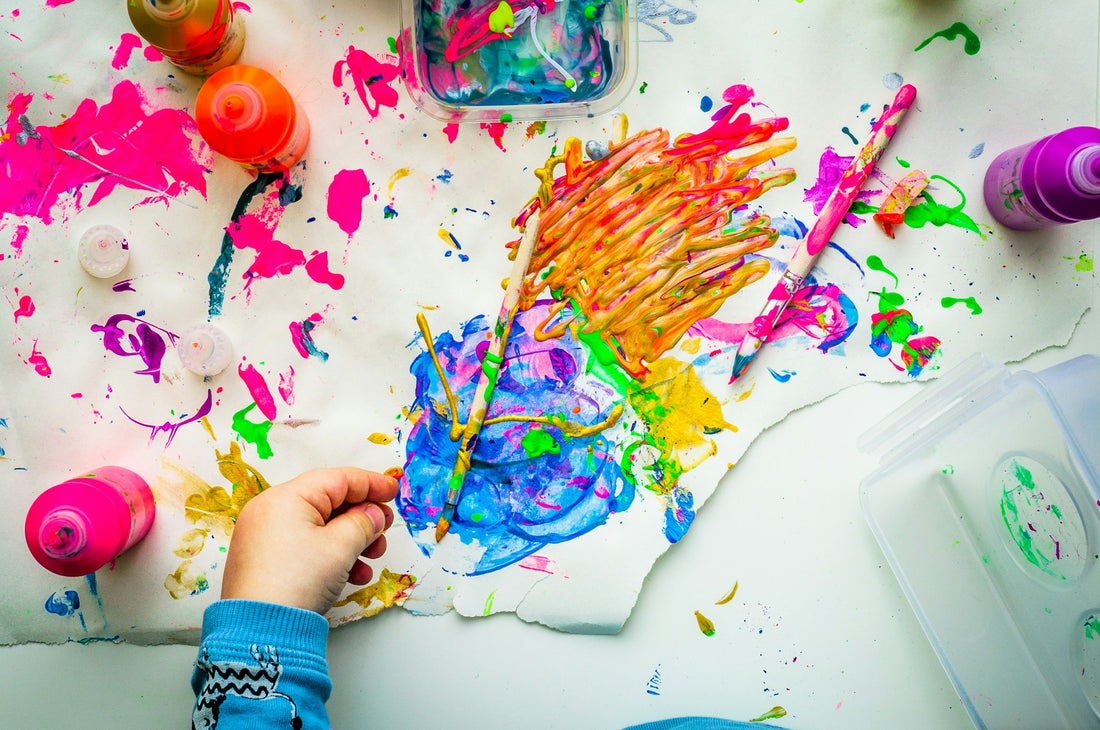Breaking into the art scene is easy for kids – there's no need to worry about expensive supplies or creating masterpieces here. Your child will likely be fine with almost any supplies you provide, as even the simplest of artistic mediums can mean hours and hours of fun for both of you.
In this guide, we'll be covering our full list of favorite art supplies for kids in detail. We made sure to include vital information like appropriate age ranges, the best supplies for complete beginners, and tons of other tips and tricks to help you get started with art-making for kids.
What's the best art medium for children?
So, what should you be looking for in your child’s new art supplies? With so many different mediums to work with, it can be a bit difficult to decide on what to pick up for your kid. There’s lots to consider, but here are a few of the most basic, general guidelines to follow:
-
Age matters, for example – younger children may not have the strength to use pencils or could be too curious and hungry for things like crayons
-
Smaller hands sometimes require bigger tools, think thick cut crayons vs. standard sizes
-
Choking is a potential risk for lots of art supplies – always watch your kids and set them up with appropriate materials
-
You may want to set aside a few sets of “art clothes” or invest in a smock or apron, which we’ll discuss below
When it comes to the art itself, your individual children will develop their own preferences over time, so it’s best to let them experiment with different mediums or kinds of art to see which they enjoy the most.
Art supplies for beginners
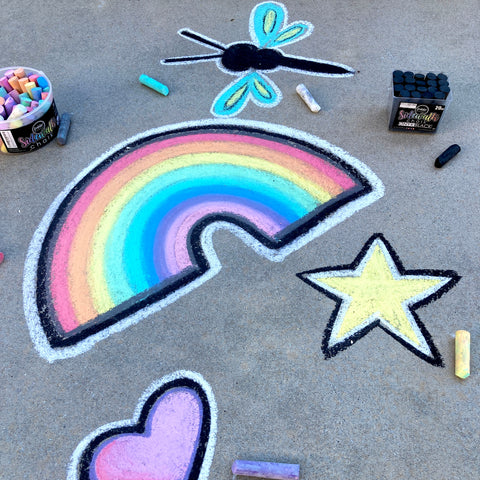
If you’re looking for an easy medium to start with, consider finger paints or crayons. Thicker crayons that can be held by toddlers are a great choice, and finger painting – while messy – is probably the most common first-time art experience for many kids.
It’s generally best to start by testing out a variety of cheaper craft supplies instead of springing for expensive art sets, and then slowly buying beginner “fine art” sets once your kid knows what they like – also, seasonal themes aren’t required for art but they are a good place to start if you’re lacking ideas.
Kids will draw on any surface, if you let them. Jokes aside, drawing on windows, walls, chalkboards, dry erase boards, sidewalks – all of these canvases work. It really just depends on how easy they are to clean off and how much you care if marks or stains are left behind.
Overall, the best kind of paper for children’s art would be construction paper or an affordable roll of butcher paper, or something similar. You want to look for sturdy paper that won’t easily tear or bleed through beneath, making construction paper an easy choice.
Why is creating art good for kids?
Art is an incredibly valuable part of any child’s life – creating art helps your kid overcome challenges, develop new skills, and even make friends or bond with family. Here are a few of the benefits associated with creating art during childhood:
-
Challenges and grows their fine motor skills and hand-eye coordination
-
Improves visual learning and language development skills
-
Promotes creativity and inventiveness
-
Can help them make friends if you join art communities
Not only that, but making art with your kid is simply just a lot of fun. If set up correctly, it can be a relaxing and stress-free way to bond and play with your kiddo without the worry of messes or impossible to clean stains.
Do age ranges matter for art?
To prevent your child from choking on or eating things that aren’t food – things like marker caps and crayons – you’ll want to buy age appropriate art supplies. Appropriate art supplies for preschoolers will obviously be a bit different than craft supplies for kids with more developed fine motor skills.
For this reason, we’ve labeled each category of art supplies with a recommended age range to stick with. Of course, this all depends on your individual child, but here are some general guidelines:
-
Toddlers: around 1 year to 3 years old
-
Grade school: around 5 years old and above
If you’re confronted with an art-related situation that’s simply just stressful for both of you, we recommend you pick a different, more suitable one. For example – if your kid is throwing a tantrum or doesn’t understand why they can’t eat or misuse certain supplies, it may be a sign you should find a different activity for the time being.
Best art supplies for kids
Here you'll find our list of art materials and crafts supplies we think your kiddos will love. Ranging from watercolor paints to craft materials meant for older kids who can be trusted with glue, all of these arts and crafts supplies will be a big hit within your creative family.
Crayons
Ages: Toddlers and up
Crayons are some of the most versatile kid’s art supplies, as they come in a range of quality, sizing, materials, and colors. Most crayons are made from wax, a mess-free material that allows your child to express their creativity without the stress of cleaning up paint spills.
With that being said, crayons will only be mess-free if your child sticks to drawing on the paper you’ve provided – a kid with a crayon set loose in your home is a recipe for disaster: hundreds of crayon marks left on every surface imaginable.
One way to avoid this is by strapping them in to their booster seat at the kitchen table, and then laying out bigger canvases like paper grocery pages, coloring books, or broken-down cardboard boxes; essentially, just provide them with a big area to go to town on with their new crayons.
If your toddler can’t handle regular crayons, consider looking for thick or egg-shaped crayons that are easier to grip and draw with before they’ve developed finger dexterity.
Sidewalk chalk

Ages: Toddlers and up
Sidewalk chalk is one of the most handy kids art supplies you can find – not only is it fun for children to use this carefree medium, it also gets them outside where they can soak up some sun before turning on the TV or tablet.
The best thing about sidewalk chalk is that it washes off surfaces like concrete and cement quite easily, allowing your kids to draw the day away outside on your driveway or patio over the weekend, giving them a bit of freedom while also keeping them safe and nearby.
We have a variety of sidewalk chalk available, ranging from our tub of 12 unique chalk colors to our plain black and white chalk package.
Play-dough
Ages: Toddlers and up
Play-dough is a classic for a reason, as kids all around the world love to mess around with the strange-smelling stuff. With that being said, you may want to hunt around for specific brands of eco dough – which is play-dough made from materials that are safe for kids to ingest if accidentally eaten.
As smelly as play-dough is, it’s one of the best introductions to physical art mediums like sculpting and clay – and it comes in tons of fun, captivating colors. Children can spend hours playing with dough, making it a solid choice for any parent with creative kids.
Make sure to pick up some extras too – hit up your local kitchen store and buy a few sets of cookie cutters or look for play-dough accessories designed to maximize fun like rollers, cutters, and other tools.
Lap desks

Ages: Toddlers and up
Lap desks designed for artistic kids are the perfect way to encourage them to make art while also making the eventual cleanup easier for you, especially if you don't have a designated art table. Here are a few of the main features of our foldable lap desks:
-
Sturdy plastic surface that’s easy to clean
-
Foldable legs that tuck away when needed
-
Storage area for notepads and supplies that latches
-
Flat working surface with areas to hold supplies while working
These kinds of lap desks work perfectly for kids who like to draw on the couch, their bed, or anywhere else that’s not a standard table or easel. They can even be used for laptops or breakfast in bed!
Protective mats and sheets
Ages: Toddlers and up
If your kid is a particularly messy artist and you don’t have space for a lap desk, you may want to consider investing in some sort of protective mat to throw underneath their drawing area. Silicone baking sheets and other kinds of simple but tough, protective sheets work perfectly for this – so don’t feel like you have to purchase an expensive art mat.
Paint supplies for kids
This section is all about painting and paint accessories for kids, which can be great for both younger or older children.
Finger paints
Ages: Toddlers and up
When it comes to finger painting, you have a few options. You could opt for regular finger paint, if you trust your little one won’t be trying to get a taste when you aren’t looking. But because some kids tend to want to try and eat whatever they get their hands on, you could also look into things like:
-
Non-toxic, edible finger paints
-
Mixing small amounts of edible paint with plain yogurt
This way, if they do try to eat the paint, it won’t be a big issue. Don’t limit yourself to painting on construction paper or canvas either – finger paints work just as well on things like rocks, scraps of wood, items bought from thrift stores, and other random objects.
Laying down an old sheet or having them paint in the bathtub before a wash are a few ways you can limit the mess around your home, but some kids will simply just go to town on a piece of paper you’ve squirted a bit of paint on – you’ll most likely have to test things out and see what your child likes to do.
Water color paints
Ages: Toddlers and up
Water colors are a classic kid’s art activity, and there are a few things you can do to make the initial setup easier and overall process of using them easier for yourself:
-
Use a cheaper set of watercolors when first starting
-
Teach your child about color combinations and the color wheel first
-
Experiment with new techniques every time you bust out the watercolors
-
Emphasize the importance of properly washing and drying the brushes out (this is essential)
-
Start by filling in simple pre-drawn designs
While going for a basic set at first is a good idea, you should generally avoid the incredibly cheap sets from dollar or discount stores – these sets are a pain to use, dry and crack quickly, and are generally just not the best to paint with even for kids.
Each watercolor painting session can be a short art lesson. By teaching them new techniques and having them experiment with and learn about combinations and the color wheel, you’ll set your kids up for success when it comes to experimenting on their own in the future.
Tempera paint
Ages: Toddlers and up
Tempera paint, also known as poster paint, is a type of paint commonly used by kids for arts and crafts projects. This type of paint is affordable, dries quickly, and is designed to be non-toxic and odorless, perfect for small children with wandering hands.
Using this kind of paint is incredibly simple: just pair some tempera paint with construction paper and set your kid up with a few brushes and you’re good to go. The best part about tempera paints is that they’re very easy to wash off, so any accidents or spills on clothing or floors can be fixed in a matter of minutes.
Paint sticks
Ages: Toddlers and up
Paint sticks are a popular choice with parents, and often come with tempera paint as the main ingredient surrounded by a plastic marker shell – which means you’ll have access to all the benefits of tempera without having to deal with brushes or water.
Perfect for younger kids and toddlers, paint sticks are a good option while traveling (car drives for example) and for parents of kids who can be trusted to recap the sticks after using them.
Sponges
Ages: Toddlers and up
Sponges are a fun way to mix things up – you can use them as an alternative to finger painting while still avoiding harder-to-hold paint brushes. A wet kitchen sponge makes an excellent paint brush itself, but you can also find specialized sponge brushes meant for things like watercolor or tempera paint.
Easels
Ages: Toddlers and up
Depending on your setup, a painting easel can be one of the best investments you’ll make for your budding artist. Easels allow artists, including your child, to paint in a position that’s made to be comfortable and easy for swapping colors, cleaning brushes, and generally just painting the day away.
If your kid is a particularly messy painter, you may want to skip the easel and just lay the painting supplies out on a table or flat surface that’s easy to wipe down afterwards. If your child still doesn’t understand the importance of brush cleaning while painting, an easel will make quite a mess with dripping brushes.
You can also use easels for non-painting art as well, as they serve as a nice surface for drawing with crayons or colored pencils too.
Smocks and aprons
Ages: Toddlers and up
If your child's interests include art, you will most likely want to pick up a smock, apron, or some other kind of clothing protection for them. The reality is, kids aren't always going to keep things clean and are likely to make quite a mess depending on what art medium they're using.
You don't necessarily have to buy a specialized apron, you could always use a spare t-shirt or old sweater, but smocks are very convenient and are quick to put on or take off. Not only that, but smocks are made from thick, durable materials that can withstand splashes of paint much easier than regular clothing.
Art boards and markers for kids
If your kid is super into markers or drawing on things like walls, you should definitely look into picking up an erasable board like one of the ones mentioned below.
Chalkboards

Ages: Grade school and up
Chalkboards are an amazing tool for artistic kids, but they do tend to work better for children who understand how to use them properly – so make sure to read our guide on how to use a chalkboard before buying one. A non-porous chalkboard can be damaged easily if scratched by things like sidewalk chalk or pens, so pairing it with regular chalk sticks or chalk markers is the best way to use them.
At Loddie Doddie, we have a ton of different chalkboards to choose from – whether you need a magnetic chalkboard calendar for keeping yourself organized while homeschooling or an outdoors chalkboard easel for kiddos who love to hang in the sun.
Note: check out our chalkboard FAQ post
Chalk markers

Ages: Grade school and up
Chalk markers are another great option for kiddos who love to draw – these markers aren’t actually chalk, but they work on surfaces designed for it. Any non-porous surface will work, including glass, plastic, chalkboards, and even ceramic or metal.
This means your child can use chalk markers to doodle on things like windows or other chalkboard-like surfaces you may have laying around, before being wiped off and cleaned for the next art session.
We have a variety of chalk marker options to choose from, including:
Note: check out our chalk marker FAQ post
Dry erase boards
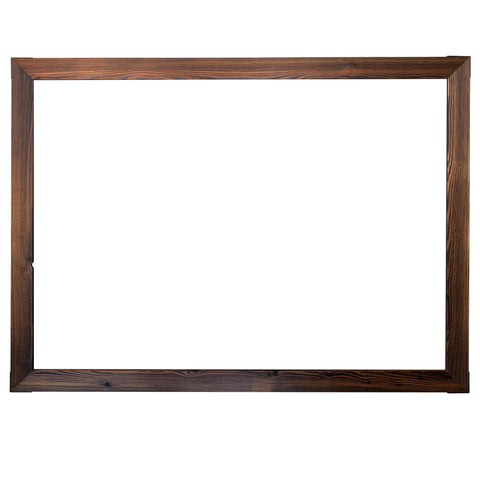
Ages: Grade school and up
Aside from chalkboards, you could also try teaching your kiddo to use a dry erase board. These are very similar to chalkboards, however you'll want to use dry erase markers on them instead of chalk. Dry erase boards are fun and engaging to draw on and simple to erase when done.
Our dry erase boards feature a magnetic surface perfectly complemented by cute magnets that can hold your child's favorite art or instructional guides; additionally, they come with a sturdy storage space for dry erase markers below the board surface and can be hung both vertically or horizontally via included hanging hardware.
Dry erase markers
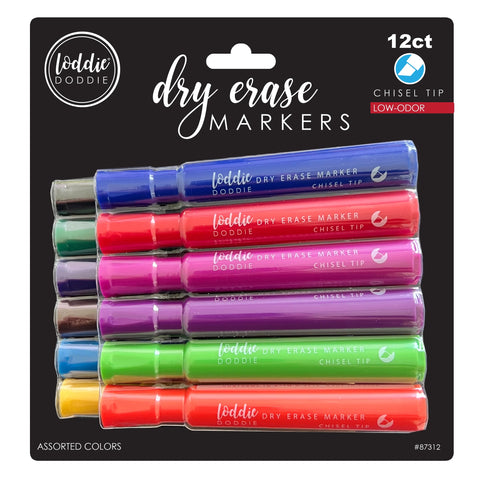
Ages: Grade school and up
Despite what you may think, dry erase markers are actually fine for kids to use. The main things to be aware of is what surface your kid uses them on, and making sure the pens get capped between uses and aren’t being chewed or nibbled on.
Less inky overall compared to other kinds of markers, dry erase markers are perfect for kids who like to draw with a bit more detail, making them more suitable for older children.
Our colorful dry erase markers are low odor and non-toxic – let your kid go crazy on your glass windows with these markers, which are easily erased without any ghosting or staining. Just make sure you use them on non-porous surfaces like glass, plastic, or dry erase boards.
Drawing and paper supplies for kids
Here you'll find a variety of more general drawing supplies, including paper options. These are some of the best supplies out there for kids who seem to take a particular interest in things like colored pencils.
Gel pens
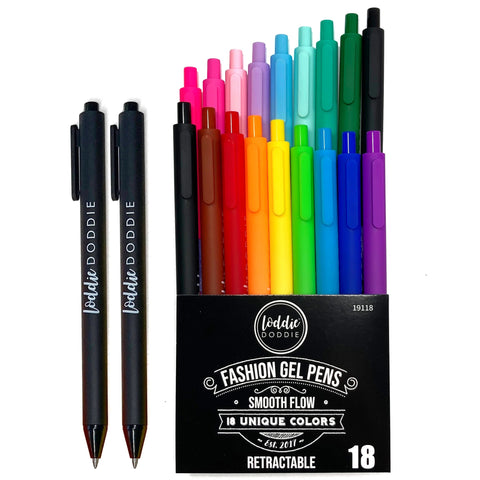
Ages: Grade school and up
Gel pens are an excellent way to introduce your child to art styles that require more dexterity than things like drawing with chalk or crayons. Our set of 24 gel pens comes with a sturdy plastic carrying case and features a range of gel pen colors and tones including neon, metallic, glitter, and pastel options.
Similar to regular pens, gel pens are a smooth way to write and draw, using vibrant colors of pigmented ink. At Loddie Doddie, we've designed our gel pens with no skipping in mind, giving you a seamless flow that even a child can use.
Colored pencils
Ages: Grade school and up
Colored pencils are a bit difficult for younger kids to use, but they’re one of the best choices for budding artists who are a bit older or possess finer motor skills. A large pack of colored pencils covering the entire spectrum is one of the finest investments you can make when it comes to encouraging your kid to create art – this is an art medium perfect for grade-school aged kids and up.
Alongside the pencils, remember to buy a quality pencil sharpener and eraser; also, you may want to look into some regular graphite pencils so your child can sketch and outline their drawings before filling them in with colors.
Erasers
Ages: Grade school and up
A big part of drawing is making mistakes – and then fixing or working with them. With that in mind, it’s plain to see why pencil erasers are a good tool to have in your kid’s art arsenal. You have a lot of options available too:
-
Rubber erasers – these are the classic pink kind
-
Vinyl erasers, which are made from plastic and tend to erase a bit better
-
Gum erasers, our favorite kind of eraser for kids that crumbles easily
-
Kneaded erasers, a sort of putty made from malleable rubber
Construction paper
Ages: Toddlers and up
Construction paper is a type of thick paper meant for drawing, sketching, and crafting. Because it’s so thick and sturdy, this kind of paper is perfect for younger kids who make a mess or can’t be trusted with a nicer sketchbook.
Affordable and available in a wide range of colors and shapes, construction paper serves as a risk-free canvas for kids to draw and experiment with.
Sketch pads
Ages: Grade school and up
Sketch pads range in quality, and include different kinds of paper depending on what you’ll be drawing or painting with. When it comes to sketch pads for kids, you’ll generally want to wait until they understand how to keep their art area clean before investing in an expensive pad, but there are budget options too if you want a pad to leave in the car.
If you like construction paper, you can also find thicker sketch pads with similar sorts of paper inside, as well as black paper perfect for pairing with colored pencils or crayons.
Coloring books
Ages: Toddlers and up
Coloring books are similar to sketch pads, but generally include permanent designs pre-drawn on the pages. These books let your little ones fill in the lines, experiment with colors, and test out a variety of mediums like crayon or pencil all in one book.
The best thing about coloring books is that you can find them for virtually any topic your kid may be obsessed with: nature, pets, superheroes – there’s no limit to the kinds of coloring books published and easily found online or at art stores.
Other paper products
Ages: Toddlers and up
Aside from the other paper products mentioned, there are quite a few other budget options out there as well. Here are a few of our favorites:
-
Rolls of plain white paper or butcher paper
-
Paper plates
-
Coffee filters
-
Grocery bags
-
Broken down cardboard boxes
If you have any of these randomly lying around – consider using them as cheap canvas for your kid’s next art project.
Miscellaneous supplies for kids
If you want to help your kiddo make collages and other kinds of crafts, you can't really go wrong with what we'll cover below. This category of supplies varies, so it's mostly limited by your creativity.
Kid scissors
Ages: Grade school and up
While regular scissors aren’t the best option for kids, blunt scissors meant for children are nice to have around. These scissors have rounded points and edges without major cutting power, making them safe for kids without fully developed motor skills while still letting them cut and alter paper and collage materials.
If you’re planning on buying things like glue and smaller craft supplies, you’ll want to pick up a pair of kid scissors to make things easier while crafting.
Glue and glue sticks
Ages: Grade school and up
Glue is the cornerstone of all kinds of different crafts and art projects your kid may be interested in – so teaching them to use this tool is essential.
Classic kinds of glue like Elmers and other brands will work fine; the main thing to look out for is a non-toxic formula designed with glue-eating kids in mind (apparently it tastes good). Most kinds of kid’s craft glues will wash out of clothes easily too, whether you’ve set them up with thick liquid glue or a twisty plastic glue stick.
Origami paper
Ages: Grade school and up
If your kid is super into art or is able to follow directions and work with smaller pieces of paper – they may love to try out some origami. Learning how to create simple origami shapes is fun for adults too, and serves as a way for you to bond with your kid over a creative activity.
Pick up a set of origami paper at your local craft store and load up some YouTube tutorials over the weekend, you may be surprised how good your little one is at origami (maybe even better than you).
Stamps and ink pads
Ages: Grade school and up
Ah, stamps. The perfect way to distract your little one for a few hours while you get a bit of work done. If you haven’t used stamps before, the basic idea is to buy a set of interesting and fun stamps, some ink pads, and a roll of paper and then let your kid go at it for a while.
You can find sets of animals, plants, letters and numbers, and lots of other types of unique designs – a range of different stamps will allow your child to express their creativity in a mess-free manner, at least compared to things like finger painting.
Always remember to teach your kid to cap the ink pads after they’ve used them, to prevent the ink from drying out.
Discount and dollar store objects
Don’t forget about your local dollar shop and thrift stores, as these are some of the top places to find the best art supplies for kids. Small wooden shapes and figurines, old vases or lamps – you’ll be able to find plenty of things to draw or paint on at discount stores, and you can even bring your kid along to pick things out.
Storage bins and containers
Art kits can be messy, so you’ll want to pick up a few storage bins or containers to keep your kid's favorite art supplies stashed when not in use. Because a lot of painting or crafting involves water and paint, it’s best to find something waterproof to store it in.
Your local crafts or home goods store will most likely stock a nice selection of storage bins to choose from if you’d prefer not to shop online.
General craft supplies
Ages: Grade school and up
Some crafts use a variety of different odds and ends for maximum fun, and in this subsection we’ll be covering some of the most common and easy to use craft supplies for your child:
Pipe cleaners
Pipe cleaners can be used for tons of different activities – making figurines, decorating collages, and all other types of twisting and tinkering. Help your kid make pipe cleaner butterflies, fairies, and flowers by following video guides, or simply just let them do whatever they feel like with these fuzzy and fun doodads.
Yarn
Similar to pipe cleaners, strands of yarn come in almost any color or material you can imagine, making them a good choice to introduce to kids who like experimenting with strange new textures to make creative shapes and art collages.
Googly-eyes
Googly-eyes are probably the single best investment you’ll make when it comes to art supplies – make some memories laughing uncontrollably with your little ones! Most kids find googly-eyes absolutely hilarious, and they come cheap in big packs found at most art stores.
Stickers
Similar to googly eyes and stamps, it’s easy for kids to become obsessed with stickers. Sold in large sheets and rolls filled with plants, animals, toys, and other shapes and designs – stickers are the perfect way for your kids to express themselves without making a big mess.
Whatever your kid is into, there’s likely going to be a huge variety of sticker options out there for them. Just make sure you keep an eye on how many they’re using, and teach them how to properly stick them!
Food items
Food can be used in crafts as well – with dried goods often being a budget-friendly choice as well. Your creativity is the limit here, with lots of food products working as craft supplies, such as:
-
Dried spaghetti strands
-
Macaroni noodles
-
Dried lentils, beans, and different types of rice
Pom-poms and cotton balls
Balls of cotton and pom-poms pair well with glue and other sorts of craft supplies, and are the perfect way to add a bit of texture and fluffiness to your children’s art. You can find these cute little fluffs in variety packs with all sorts of sizes and colors ready to be used.
Popsicle sticks
Popsicle sticks are great for creative young kids who like to build and design unique shapes and sculptures. Gluing them together to make houses and castles, or just setting them up on paper alongside cotton balls and tissue paper are just a few possibilities.
Tissue paper
Similar to pom-poms, you can find packs of tissue paper in most colors – this type of paper can be torn, crumpled, and twisted as much as your kid desires, and works well with glue or glue sticks on top of construction paper.
Final thoughts
Picking out your kids' art supplies is made easy when following a guide like ours. Whether you're looking for art materials for toddlers or painting supplies for kids who can handle more delicate mediums, making the decision to inspire creativity within your child's mind is one of the best choices you can make.
